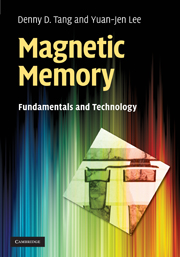Book contents
- Frontmatter
- Contents
- Preface
- Acknowledgments
- 1 Basic electromagnetism
- 2 Magnetic films
- 3 Properties of patterned ferromagnetic films
- 4 Magnetoresistance effects
- 5 Field-write mode MRAMs
- 6 Spin-torque-transfer mode MRAM
- 7 Applications of MTJ-based technology
- Appendix A Unit conversion table for cgs and SI units
- Appendix B Dimensions of units of magnetism
- Appendix C Physical constants
- Appendix D Gaussian distribution and quantile plots
- Appendix E Weibull distribution
- Appendix F Time-dependent dielectric breakdown (TDDB) of magnetic tunnel junction devices
- Appendix G Binomial distribution and Poisson distribution
- Appendix H Defect density and the breakdown/TMR distribution of MTJ devices
- Appendix I Fe, Ni and Co material parameters
- Appendix J Soft error, hard fail and design margin
- Index
- References
1 - Basic electromagnetism
Published online by Cambridge University Press: 06 July 2010
- Frontmatter
- Contents
- Preface
- Acknowledgments
- 1 Basic electromagnetism
- 2 Magnetic films
- 3 Properties of patterned ferromagnetic films
- 4 Magnetoresistance effects
- 5 Field-write mode MRAMs
- 6 Spin-torque-transfer mode MRAM
- 7 Applications of MTJ-based technology
- Appendix A Unit conversion table for cgs and SI units
- Appendix B Dimensions of units of magnetism
- Appendix C Physical constants
- Appendix D Gaussian distribution and quantile plots
- Appendix E Weibull distribution
- Appendix F Time-dependent dielectric breakdown (TDDB) of magnetic tunnel junction devices
- Appendix G Binomial distribution and Poisson distribution
- Appendix H Defect density and the breakdown/TMR distribution of MTJ devices
- Appendix I Fe, Ni and Co material parameters
- Appendix J Soft error, hard fail and design margin
- Index
- References
Summary
Introduction
Two thousand years ago, the Chinese invented the compass, a special metallic needle with one end always pointing to the North Pole. That was the first recorded human application of magnetism. Important understandings and developments were achieved in the mid 19th century and continue into the present day. Indeed, today, magnetic devices are ubiquitous. For example, to name just two: energy conversion devices provide electricity to our homes and magnetic recording devices store data in our computers. This chapter provides an introduction to basic magnetism. Starting from the simple attractive (or repelling) force between magnets, we define magnetic field, dipole moment, torque, energy and its equivalence to current. Then we will state the Maxwell equations, which describe electromagnetism, or the relationship between electricity and magnetism.
A great tutorial is provided by Kittel, which may be used to support students studyingChapters 1–4.
Magnetic forces, poles and fields
In the early days, magnetic phenomena were described as analogous to electrical phenomena: like an electric charge, a magnetic pole was considered to be the source of magnetic field and force. The magnetic field was defined through the concept of force exerted on one pole by another.
- Type
- Chapter
- Information
- Magnetic MemoryFundamentals and Technology, pp. 1 - 12Publisher: Cambridge University PressPrint publication year: 2010

